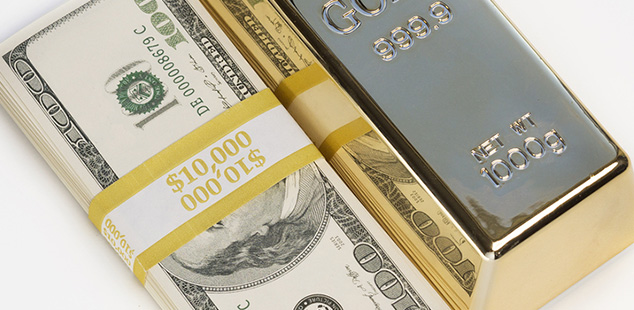
If you feel like you can get a bit more from each greenback in your wallet these days—more gas, more Christmas presents, more vacation abroad—you’re not wrong. The U.S. dollar has just hit a 12-year high and, as any gold investors know, when you want a hedge against a poorly-performing dollar, precious metals provide your best certainty. In an environment where the dollar has more muscle, the gold price has taken it on the chin. After a brief resurgence in autumn where gold flirted with $1,200 per ounce, it has now dropped steadily and appears perilously close to going below $1,000 by 2016, the lowest point in six years. While some gold investors may be willing to throw up their hands and say “enough,” those who are patient will reap the benefit of the turning tides.
Theatrics
Gold, at the moment, lies “at the end of the second act in a three-part drama,” according to Australian investment bank Macquarie. The first, which investors enjoyed to great extent from 2008 to 2012, saw the value of the metal rise tremendously on the back of one of the worst economic crises in the nation’s history. At a time when the dollar fell flat and needed quantitative easing in order to breathe life back into currency, gold rose to historic highs of nearly $2,000 per ounce. Other commodities followed suit, including oil, silver, coffee, natural gas, and cattle. The commodity bubble performed quite well up until 2012, when the second act kicked in and many investors decided to sell high rather than buy up more raw resources at peak prices. Since then, liquidity has been king, much to the demise of precious metals. Gold has nearly halved, while oil has fallen by two-thirds. Just as 2012 represented the peak, however, we will remember 2015 as the nadir and the start of the recovery.
Small Steps
By far the most important spark plug to a gold recovery lies in the hands of Federal Reserve chairwoman Janet Yellen, a name infamous amongst commodity investors and economists alike. The former blame null inflationary policies on the decline of commodities, while the latter claim that her laissez-faire attitude hurts the ongoing recovery. Yet Yellen has finally conjured up a silver cloud on the horizon, claiming for weeks that the Fed will “barring unexpected surprises” raise interest rates on the dollar—for the first time in ten years—in a pre-Christmas strategy session. The good news already sent gold up on some small initial spikes.
Rate Hike
Indeed, as has been widely expected, Yellen and the Federal Reserve approved the first interest rate hike in seven years during the last two-day meeting of the year on December 16 and 17, from 0.00% to 0.25%. Now, says Macquerie analyst Matthew Turner, the third act kicks in. There are a few scenarios, some happier and some less than happy: upward pressure on gold could create a new metal surge, though likely not as strong as that of the recession era. A flagging dollar could result in more interest in inflationary hedges. A strong recovery could push the greenback forward and offer only a brief blip to gold’s recovery, but this would require a number of favorable circumstances. With gold set low on the horizon and the Federal Reserve decision now behind us, other global economic factors could also return to the forefront. Buying gold will always be a safe haven decision as an investment against inflation, war and economic catastrophe, not to mention long-term security, so those holding gold already are positioned for anything.

